A 'Calming Presence' at the Helm

Thomas J. Bisacquino, NAIOP’s long-serving president and CEO, retires after three decades with the association.
It has been said that adversity doesn’t build a person’s character, it reveals it. If so, then Thomas J. Bisacquino, who is retiring this summer as NAIOP’s president and CEO after 33 years with the association, revealed his strength of character right from the start of his tenure — and continuously thereafter.
“NAIOP members live in a volatile industry, with many ups and downs, and Tom’s level head and consistency were a calming presence to all of us as we rode out the cycles that are a part of our world,” said Phil Stevenson, NAIOP’s 1999 chair and a partner with the Clear Creek Group in Jackson Hole, Wyoming.
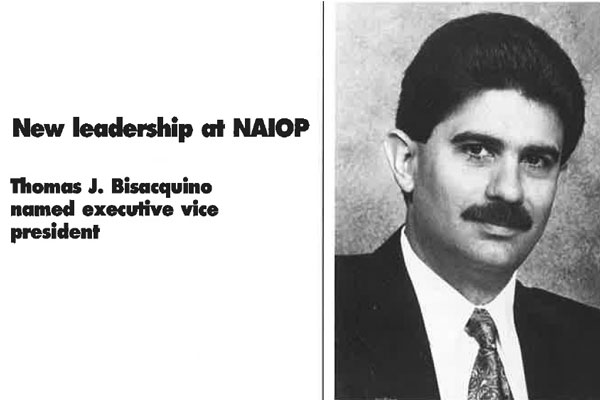
Bisacquino was elevated to the role of NAIOP’s executive vice president (the equivalent of president and CEO) in 1991.
Indeed, Bisacquino’s career with NAIOP could be seen as a series of proactive responses to the crises and radical transformations that shook up the commercial real estate industry during the past four decades.
“The industry changed dramatically during Tom’s tenure, and he adapted the organization to meet and exceed the demands of those changes,” said Jim Neyer, former executive vice president with AI. Neyer in Cincinnati and NAIOP’s 2018 chair.
Baptism by Fire
After serving as assistant executive director for the Association for Systems Management in Cleveland, Ohio, Bisacquino arrived at NAIOP in 1988 as senior vice president and chief operations officer. He made an immediate positive impression.
“He walked in the door good at everything,” said Shirley Maloney, who was the association’s vice president of marketing at the time. “He had an excellent understanding of government affairs, education, finance, all the different areas of the organization.”
A year later, a natural disaster during the association’s most important event forced him to take control of a chaotic situation.
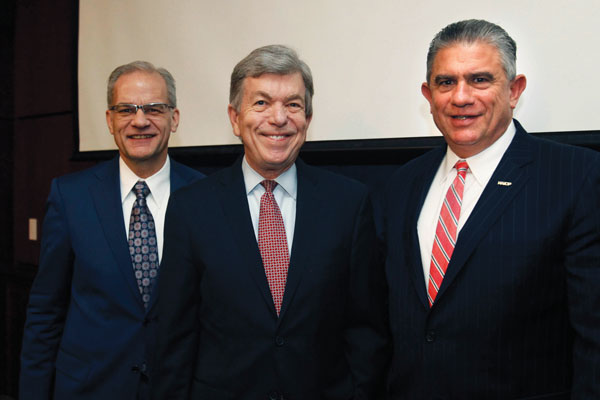
Bisacquino with Sen. Roy Blount, R-Missouri, center, and 2018 NAIOP Chair Jim Neyer of Cincinnati-based Al. Neyer during the February 2018 Chapter Leadership & Legislative Retreat in Washington, D.C.
In October 1989, NAIOP was scheduled to hold its annual conference in San Francisco. Maloney recalled that October 17 was NAIOP’s move-in day at the Fairmont San Francisco hotel.
“We had our exhibitors setting up in the exhibition hall, we were preparing to go to the board dinner that night, and most of the attendees were due to come in the next morning,” she said.
And then, at 5:04 p.m. local time, a magnitude 6.9 earthquake struck Northern California, causing 63 fatalities and more than $6 billion in damages.
“The whole place just shook,” Maloney recalls. “And then all the power went out at the hotel.”
After a tense night in the dark, NAIOP’s leadership had to make difficult decisions the next morning. Bisacquino gathered with the executive committee, and they agreed to cancel the conference. (It was eventually rescheduled for Palm Desert, California, in February 1990.)
“The airport was closed,” Maloney said. “The hotel had no power or water. We couldn’t continue with the conference. It was a huge decision to make. Then he had to get the people who were on-site home safely, and he had to undo everything that had been done.”
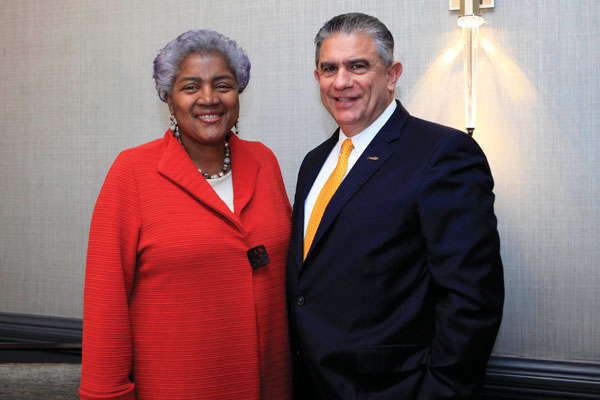
Political strategist and CNN contributor Donna Brazile, who has twice served as chair of the Democratic National Committee, has been a frequent speaker at NAIOP events during Bisacquino’s tenure.
According to Maloney, it was a moment that demonstrated Bisacquino’s leadership skills.
“I think Tom showed his mettle at that conference,” she said. “He didn’t shirk from having to sort this whole thing out. It really was a wild start to his career at NAIOP. But it showed right from the very beginning that whatever it took, he’d take care of it.”
CRE Turbulence in the Early ‘90s
Bisacquino was promoted to NAIOP CEO in 1991, but his early years leading the association were difficult for commercial real estate.
“In the mid- to late-1980s, records were broken with 15,000 new shopping centers and $300 billion in office space — more than doubling available space in both sectors,” according to an article in the January-February 1991 issue of Development magazine. “The cash flow was fueled by tax incentives for virtually every conceivable property type, investment tax credits and the sharp reduction in depreciation life on most types of holdings.”
That frenetic activity had a downside, however.
“While the commercial real estate market was in hyperdrive during most of 1980s, by 1989 properties eventually were overbuilt in almost every city,” said Ron Rayevich, president of RayMar Associates, Inc., in Sarasota, Florida, who served as NAIOP’s chair in 1997.
Awash in overvalued properties and with changes to tax laws that made commercial real estate a less attractive investment, the industry entered a steep decline. Within a few years, credit for development projects virtually disappeared, and there were few buyers for overpriced buildings. At the same time, a third of all savings and loan associations, which were major suppliers of commercial mortgages in the U.S., failed between 1986 to 1995.
“Many of the more volatile U.S. markets saw office property values decline by as much as 50%, with no real bottom in sight,” Rayevich said. “It took until the mid-1990s for real estate values to even approach what they were in 1989.”
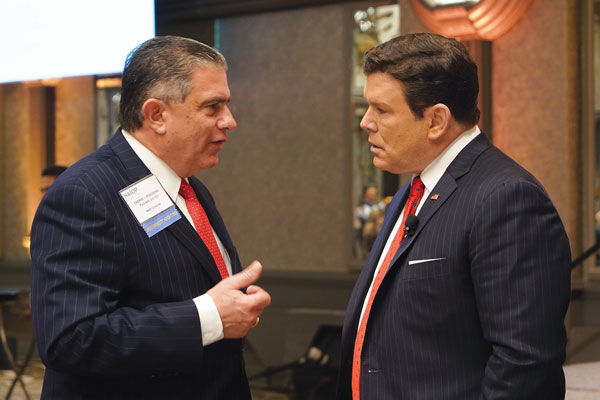
Bisacquino shares a moment with Fox News Chief Political Correspondent Bret Baier during the Chapter Leadership & Legislative Retreat in Washington, D.C., in February 2020.
The crash had a profound effect on NAIOP’s membership numbers. In 1988, the association had roughly 7,500 members. By 1993, there were just 4,449 members.
In a 1991 Development magazine article, Bisacquino described traveling across the U.S. to assess how NAIOP’s members were coping with the crisis.
“It’s one thing to read about some of the difficulties our members are experiencing, but it’s really another to see it face to face,” he said. “When you see creditworthy members who have very solid product having serious problems — a lender calls a loan, and no one is willing to refinance — it’s a real eye-opener.”
That experience clearly affected Bisacquino, who said he would do everything he could to ensure that NAIOP evolved “to meet the changing needs of our membership, and to be proactive rather than reactive in all of our services.” That credo guided his leadership of the association for the next three decades.
Creative Solutions to Complex Problems
Paul Novak, the executive director for lodging at Whitman Peterson in Key Biscayne, Florida, joined NAIOP in the 1980s. While conditions slowly improved as the 1990s progressed, it was still a difficult time to be in commercial real estate. To address the ongoing crisis, Novak said he and Bisacquino crafted an innovative solution that helped both the association and the industry.
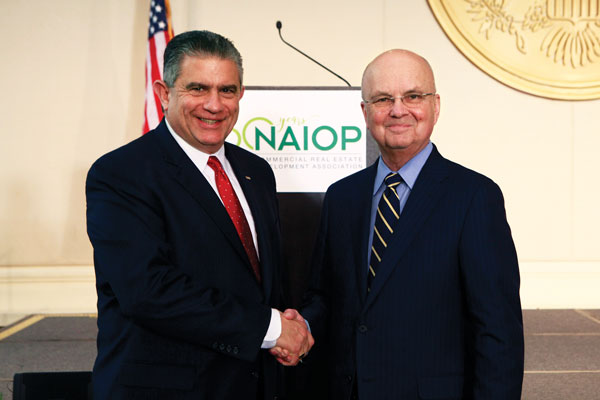
Bisacquino greets Gen. Michael Hayden, a former director of the Central Intelligence Agency and the National Security Agency, during the February 2017 Chapter Leadership & Legislative Retreat in Washington, D.C.
“I came up with an idea to have an auction of distressed real estate or properties that members were trying to dispose of,” he said. “Tom and I worked very closely together, and we ended up sponsoring two auctions.”
The first auction was held during NAIOP’s annual conference in Dallas in 1993. According to the Fall 1994 issue of Development magazine, it produced more than $400 million in sales. Another one took place at the 1994 annual conference in Boston. Collectively, the auctions generated approximately $600,000 in commissions for the association.
When Novak became NAIOP’s chair in 1995, both the industry and the association were on much better financial footing.
“I think everybody would say that those auctions probably saved NAIOP,” he said. “If it had not been for Tom’s ability to envision the concept and his willingness to hold NAIOP-sponsored auctions to generate commissions, it never would have happened. It allowed the association to retain its staffing during that downturn, and because of that, NAIOP flourished.”
Maloney said Bisacquino’s efforts in the early years of his NAIOP career proved his savvy as a fiscal manager.
“Despite what we had thrown at us, he always managed to keep a solid bottom line for the organization, and he did his best not to have it impact member services,” she said.
National Forums and the NAIOP Research Foundation
The mid- to late 1990s were much better times for the commercial real estate industry. NAIOP was also picking up speed under Bisacquino’s leadership.
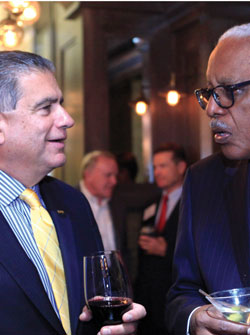
Bisacquino chats with Dwight Taylor of Pikesville, Maryland-based Stonegate Partners during a social hour at CRE.Converge 2017 in Chicago.
In 1995, Bisacquino approved the launch of NAIOP’s National Forums, one of the association’s flagship programs. The Forums provide exclusive networking and experience exchange among NAIOP members in a confidential small-group setting. The program, which debuted at the October 1995 annual conference in Las Vegas, began with 100 members in four Forums. As of the spring of 2022, there are more than 900 members in 57 Forums groups.
And in 2000, Bisacquino was a founding member of the NAIOP Research Foundation. Established as a 501(c)(3) and supported by a board of governors, the Foundation produces research on industry trends and provides it free of charge.
Advocacy Efforts
The association hired its first full-time lobbyist in 1988. In 1989, Bisacquino played a key role in the establishment of NAIOP’s political action committee (PAC), which is still active. Funded by personal contributions from NAIOP members who are U.S. citizens, its aim is to help NAIOP’s lobbying team build critical relationships so that policymakers understand the commercial real estate industry.
“Tom advocates for the industry and understands the real issues for the members on Capitol Hill and state legislatures,” said Neyer. “I had the pleasure of being with Tom at many events where notable politicians sought him out to assure him that NAIOP’s issues were top of mind.”
During Bisacquino’s tenure, NAIOP’s government-affairs efforts scored numerous legislative wins for the commercial real estate industry in areas including brownfields revitalization, tax policy and terrorism risk insurance in the wake of 9/11.
“We all witnessed Tom’s passion for legislative issues facing our industry,” said Bill Hunt, CEO of the Elmhurst Group and NAIOP’s 2012 chair. “As Tom always says, ‘if you’re not at the table, then you are on the menu.’ ”
Chapters Expand Across North America
Another hallmark of Bisacquino’s time has been steady growth of the association, both in the number of members and in the geographic scope of NAIOP’s reach. The chapter network has played a critical role in that growth.
The first NAIOP chapter was founded in 1970 in New Jersey, just three years after the association itself. By 1977, there were 30 chapters across the U.S. Today, there are 52 chapters across North America that provide networking, education and advocacy for commercial real estate professionals at the local level.
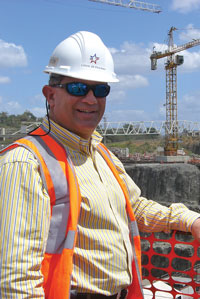
In March 2012, Bisacquino escorted 20 NAIOP members and staff to tour the Panama Canal, where a huge construction project was underway to widen the locks in order to accommodate larger container ships.
According to local chapter leaders, Bisacquino’s strong support of the chapter network played a key role in their expansion.
“I have been working with state, national and international associations since 1980,” said Kathie A. Barstnar, executive director of NAIOP Colorado. “Never have I experienced a leader of Tom’s integrity, influence, gratitude and empathy. His willingness to do whatever he could to help chapters succeed is unsurpassed.”
Martha Marks, president of NAIOP Northern Virginia and a colleague of Bisacquino’s since 1990, remarked, “Tom’s steady leadership charted our course, steered our ship and created a successful fleet of chapters throughout the United States and Canada.”
In 1994, NAIOP launched its first Canadian chapter, in Vancouver, British Columbia. A year later, Greater Toronto joined the fold. NAIOP expanded to Calgary in 2002 and Edmonton in 2012. Today, NAIOP’s Canadian membership is nearly 2,000.
NAIOP’s relationships south of the border also expanded during Bisacquino’s tenure. In January 2006, the association signed a letter of cooperation with AMPIP, the Mexican Association of Office Parks.
A Helping Hand
Despite the dot-com bubble bursting and the shock of the 9/11 terror attacks in the early 2000s, NAIOP held strong. In the Winter 2001 issue of Development magazine, 2001 NAIOP Chair Anne Evans Estabrook, owner and chair of Elberson Development Group in New Jersey, noted that the association had built a reserve fund of more than 50% of its annual budget and had grown to 9,700 members, 500 more than in 2000.
Bisacquino’s next challenge was to push NAIOP — and the industry — to expand opportunities to groups that had long been under-represented in commercial real estate.
In 2002, NAIOP formed a partnership with Project REAP (Real Estate Associate Program), a market-driven, industry-backed organization that recruits and develops minorities for roles in commercial real estate through education, networking and on-the-job training. Bisacquino was on Project REAP’s corporate board from 2002 to 2018, and he served on its executive committee for eight years.
In 2017, NAIOP formalized a relationship with the Real Estate Executive Council (REEC), a trade association that promotes the interests of executives of color in commercial real estate. In July 2017, NAIOP and its Georgia chapter worked with REEC and Georgia State University to launch the first commercial real estate summer immersion program for minority high school students. To date, hundreds of these students have been introduced to CRE through this program, with many choosing it as their ultimate career path.
And in 2006, NAIOP launched the Developing Leaders program geared toward commercial real estate professionals age 35 and under.
“One of our big initiatives of that time came about when we realized that a lot of young people were not choosing real estate as a career,” said Douglas Howe, founder and CEO of Touchstone in Seattle and 2009 NAIOP chair. “Tom encouraged a big push to get them into the industry.”
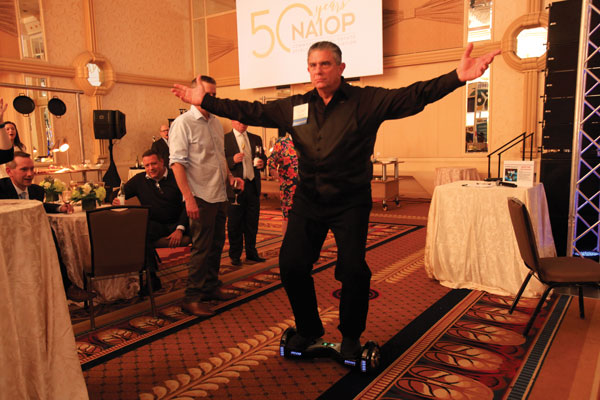
Biscacquino takes a micromobility device for a spin around the ballroom during the 2017 Chapter Leadership & Legislative Retreat in Washington, D.C. The event marked NAIOP’s 50th anniversary.
Membership growth continued, and by 2008 there were 18,000 members. But that year, another shock hit commercial real estate — the Global Financial Crisis. U.S. GDP fell 3.8% in the fourth quarter of that year, and unemployment reached 7.6% early in 2009. Vacancies in commercial properties skyrocketed.
“We realized we had a loss of revenue from our programs,”
Howe said. “We lost a lot of members, and it was financially devastating for many of them. It was a terrible year.”
Howe said Bisacquino decided that helping NAIOP’s members would become the defining theme for 2009.
“Under Tom’s leadership, we decided that NAIOP should offer more, not less,” Howe said. “We had to reinvent ourselves in 2009 to make ourselves more accessible to our members.”
To that end, Bisacquino announced NAIOP’s Four-Point Promise to members in February 2009.
First, NAIOP responded to the credit and capital crisis by establishing a member-driven Commercial Credit and Capital Advisory Board. Second, the association launched a new audio series entitled “Economic Insights.” These were timely, Web-based economic reports from industry veterans on how to survive in difficult markets. Third, the NAIOP Research Foundation produced new studies on commercial real estate’s economic contributions to the nation and the macroeconomic indicators that drive new development. And fourth, NAIOP promised to allow members to stay with the association even if they had lost their jobs and couldn’t afford to pay dues.
A Swift Response to COVID-19
In December 2019, NAIOP reached a remarkable milestone — its 20,000th member. But soon thereafter, the COVID-19 pandemic rapidly rattled the global economy and the businesses of the association’s members.
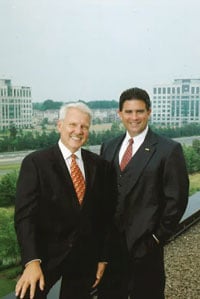
Bisacquino with David M. Jellison, NAIOP’s 2002 chair, at the association’s headquarters in Herndon, Virginia. Jellison served for many years as vice president with Liberty Property Trust in Minnesota.
The pandemic “abruptly plunged the U.S. economy into a deep downturn as entire states mandated business closures and social distancing to control the spread of COVID-19,” according to an article in the Summer 2020 issue of Development magazine. “Those shutdowns and unprecedented job losses, in turn, threaten the commercial real estate industry, which depends on thriving businesses that can pay rent for the space they occupy.”
Once again, Bisacquino led NAIOP through a crisis.
He urged NAIOP’s education department, which had embraced digital learning tools way before many others in the association space, to launch a series of in-depth webinars. From late March to early June 2020, NAIOP offered 22 free, members-only webinars on topics related to COVID-19’s impact on commercial real estate. Instead of cancelling conferences, NAIOP turned them into well-attended, profitable virtual events.
He asked the staff of Development magazine to completely revamp the Summer issue of the magazine and create an issue entirely focused on the pandemic in just a few weeks.
And from April 2020 to February 2021, the NAIOP Research Foundation conducted seven surveys of members on the impacts of COVID-19 on their businesses.
The result was that NAIOP came through the crisis in outstanding financial condition and with only a slight dip in membership.
It was a fitting penultimate career chapter for a man who had done so much for the association and the commercial real estate industry.
“Tom was never satisfied with the status quo,” said Greg Fuller, president and COO of Granite Properties and NAIOP’s 2019 chair. “NAIOP radically changed over his tenure. Be it various recessions, changes in technology, COVID-19 or whatever came up, he navigated those choppy waters with calm and determination to be better on the other side. Tom was always protective of the NAIOP brand and his staff. We are all better off personally and in our businesses because of this association and what Tom created over the past 33 years. He has left this organization in great shape, and for that we should all be very grateful.”
Trey Barrineau is the managing editor of publications for NAIOP.




